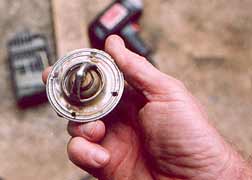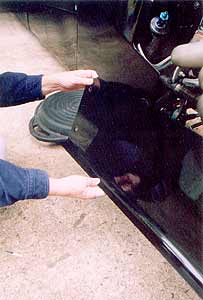
HOLEY, HOLEY, HOLEY

In the photo, notice the four holes we drilled
in an old thermostat. Our drill, drill bits
and a piece of 2-by-4 wood lie on the driveway.
It takes only a minute or two to complete
this Joe Haddon Quik Trix. |
Footbrake racer extraordinaire Joe Haddon of
Conyers, Georgia, gave us this Quik Trik. He
kept having heating problems with his 10-second
Chevy II, and tried everything to keep his small-block
Chevy cooled between rounds --- squirting down
the radiator, running the fan extra-long, adding
water between rounds, etc. He finally came up
with this simple idea. He took the thermostat
out of the water neck on his intake and drilled
four small holes in the thermostat. He found
that it aided in the water flow to the engine
and intake when he first starts the engine on
a Saturday afternoon. The drilled thermostat
also acts as a pressure release or a pressure
balancer. His 180-degree drilled thermostat,
he found, also modifies the water temperature
to a degree (no pun intended). During the rest
of the racing day, the “holey” thermostat,
he found, gets the radiator water flowing past
the thermostat, helping cool the engine that
much more. This one is a cheap Quik Trix and
should be used on an experimental basis. But
hey, Joe says it works, and we believe him.
He used to have his pit area covered with water
from his water sprayer. No more.
DON’T GIVE ME NO LIP
| We used Fran’s
hands as a model to show you the difference
between the two dragster body panels. She
is holding the front piece on our new Fabrication
Concepts front-engine dragster, completed
in 2004, while her dragster’s panels,
circa 1989, are in the background. Note
how my FED has the bottoms bent outwards,
while her older digger’s panels tuck
inward. Our rubber donut is placed underneath
Fran’s dragster, and acts as a cushion
in the trailer. |
 |
It used to be that dragster builders rounded
the lips of body panels to the inside --- down
and under --- of the dragster’s frames
as THE proper way to outfit the panels to the
car’s tube frame. Not any more. Now most
newly-built dragsters have a lip that bends
outwards of the frame, and there is a good reason
for that --- many dragster racers nowadays use
a rubber “donut” that sits on the
trailer floor between the dragster’s frame
crossbar that is welded to the bottom of the
frame around the driver’s compartment.
The donut prevents the dragster frame from getting
cracked and bent when being hauled around in
the trailer. And with the body panels bend out,
they don’t get bent or warped when the
donut is set in place and the car lowered onto
the top of it. Outer-rounded body panels also
help when it becomes necessary to set the dragster
on jack stands. We found this to be especially
true when jacking up our new Fabrication Concepts
front-engine digger for jack stands. Fran’s
1989-model dragster has the panels bent to the
underside and inside of its frame rails, and
we bent a couple of them before learning to
place jack stands on the innermost part of its
frame. Again, logic dictated this change among
builders, and in this case, newer is definitely
better.

|